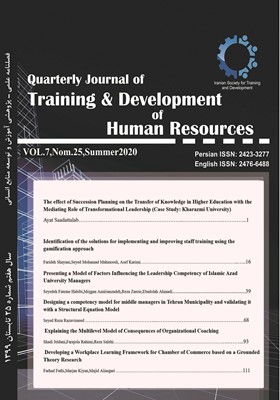Presenting a Model of Factors Influencing the Leadership Competency of Islamic Azad University Managers
Subject Areas :سیده فاطمه حبیبی 1 , Mojghan Amirianzadeh 2 , reza zarei 3 , Ebadalah Ahmadi 4
1 -
2 -
3 -
4 -
Keywords: : Leadership, Management, Competence, Higher Education, University,
Abstract :
Background and Purpose The purpose of this study was to present a model of factors affecting the leadership competency of Islamic Azad University managers. Method This research is a mixed method research in qualitative and quantitative in descriptive-survey method. Participants in the qualitative section consisted of 21 academic experts selected by purposeful method using key experts and theoretical saturation method. In the quantitative section, all faculty and staff of Islamic Azad University of Fars province numbered 1800. Morgan table was used to determine the sample size. Based on this table, 187 faculty members and staff of Islamic Azad University of Fars were selected. The research tools were used in qualitative, exploratory and semi-structured interviews and in a small part by a researcher-made questionnaire; factors influencing managers' leadership competency were designed based on the themes obtained in the qualitative stage. Results Results in qualitative section revealed the factors influencing leadership competence in the form of 21 basic attributes, 4 organizer attributes (ethical, motivational, managerial, structural) and two pervasive factors (individual and organizational) that based on these findings the effective factors model Leadership competency was designed and quantitative results showed that the structural factor in universities had a great impact on the competencies of leaders and managers, and the model obtained had a good fit. Conclusion According to the results of the research, four factors affecting leadership competency are identified: ethical, motivational, managerial, structural, which require macro and micro strategies that lead to emergence and emergence of leadership competencies in Azad university managers. To be adopted.
1- سلامیان،حسن،مرادی دولیکانی،مرتضی(1397).مقاله شناسایی مولفه ها و نشانگرهای اخلاق پژوهش در آموزش عالی و واکاوی آنها در منابع روش تحقیق فارسی،فصلنامه نامه آموزش عالی،(12)45،صص31-67
2- Zaman, K. .2015. Quality guidelines for good governance in higher education across the globe. Pacific Science Review B: Humanities and Social Sciences, 1(1),pp 1-7.
3- Yáñez, S., Uruburu, Á., Moreno, A., & Lumbreras, J. (2019). The sustainability report as an essential tool for the holistic and strategic vision of higher education institutions. Journal of Cleaner Production, 207.
4- Hu .P.(2017)“Notes Instruction of economics at higher education: A literature review of the unchanging method of talk and chalk” journal homepage The International Journal of Management Education 15 (2017) 30e35.
5- قربان نژاد، پریسا، عیسی خانی، احمد،(1395). ﻃﺮاﺣﯽ ﻣﺪل ﺷﺎﯾﺴﺘﮕﯽ ﻣﺪﯾﺮان داﻧﺸﮕﺎﻫﯽ ﺑﺮ اﺳﺎس اﻟﮕﻮﻫﺎي اﺳﻼﻣﯽ : ﻣﻄﺎﻟﻌﻪ اي ﺗﻄﺒﯿﻘﯽ،فصلنامه ﻣﺪﯾﺮﯾﺖ در داﻧﺸﮕﺎه اﺳﻼﻣﯽ،سال5،ش11
6- Niroumand P, Bamdad soofy J, Aerabi SM, Amiri M. [A Conceptual Framework for competencies of CEOs Engaged in Technology- Based Firms CEOs: Dimensions, Factors and Indies]. Quarterly Journal of Career & Organizational Counseling 2012; 4(12): 145161. [Persian]
7- پورکریمی، جواد، صداقت،مریم،(1392). ﺗﺒﻴﻴﻦ راﺑﻄﻪ شایستگی با سبک رهبری تحول افرین مدیران در سازمان های پژوهشی،ﻓﺼﻠﻨﺎﻣﻪ ﭘﮋوﻫﺶ ي ﺣﺴﻴﻦ ﻫﺎي ﻣﺪﻳﺮﻳﺖ ﻣﻨﺎﺑﻊ اﻧﺴﺎﻧﻲ داﻧﺸﮕﺎه ﺟﺎﻣﻊ اﻣﺎم (ع ) ﺳﺎلﺷﺸﻢ ﺷﻤﺎره ، 1ص201-222
8- هجرتی ،منیرالسادات .(1395)نگاهی گذرا بر نظام اموزش عالی کشور و برخی چالشهای ان.کنگره ملی آموزش عالی ایران
9- Beveren.P(2017).Psychometric properties of the Portuguese version of the GlobalTransformational Leadership (GTL) scale"Journal of Work and Organizational Psychologywww. el s e vi e r. e s/ r p t o
10- Winston, B.E. & Patterson, K. (2017). “An integrative definition of leadership,” International Journal of Leadership Studies, 1 (2), pp. 6–66.
11- Radula.M , Benjamin M. Galvinb, Lynn M. Shorec, Karen Holcombe Ehrharta,Beth G(2017). Inclusive leadership: Realizing positive outcomes through
12- Berger, B. K., & Meng, J. (2010). Public relations practitioners and the leadership
13- رابینز، استیفن وجاج،تیموتی، ترجمه زارع،مهدی،(1392)،رفتارسازمانی، جلد اول،تهران،نص
14- علاقه بند،ع(1390)،مدیریت عمومی،نشر روان،تهران
15- قلیج لی،ب،صفاری،م(1395).کتاب توسعه شایستگی مدیران (رهبری)چاپ اول،تهران:انتشارات اشراقی.
16- Spencer, L. M., & Spencer, S. M. (1993).Competency at Work: Model for Superior Performance,” John Wiley & Sons.
17- پورعزت ع. (1390). مبانی مدیریت دولتی. تهران: انتشارات سمت .
18- احمدی،الف، فاضلی کبریا،ح، فقیه،حمد،ب (1392 )طراحی مدل مفهومی عمومی شاخص ها و مؤلفه هاي برنامه ریزي نیروي انسانی مبتنی بر شایستگی ها. 147- فصلنامه راهبرد / سال بیست و دوم / شماره 66 / بهار 1392 / صص 17
19- نصر اصفهاني، مهدي؛ نصر اصفهاني، علي؛ شايسته سالاري در مديريت جامعه با تاكيد بر انديشه هاي سياسي امام علي7، معرفت سياسي، 2، 1389، ص141-160
20- ﮐﻠﯿﻨﯽ، م(1365). اﻟﮑﺎﻓﯽ، ﺗﺤﻘﯿﻖ ﻋﻠﯽاﮐﺒﺮ ﻏﻔﺎري، ﺗﻬﺮان: داراﻟﮑﺘﺐ اﻻﺳﻼﻣﯿﻪ
21- مکارم شیرازی، ن(1378). اخلاق در قرآن جلد1.قم: انتشارات امام علی بن ابیطالب (ع).
22- الهامي نيا ،ع.(1391). اخلاق اسلامي.قم: زمزم هدایت
23- محدثی،ج(1385)،اخلاق تربیتی امام رضا(ع)،مشهد،نشرمطهر.
24- Taher, Samer (2007), Competency Based Human Resource Management Program, MEIRC Consultant and Train ing Company, pp48.
25- حسینی،ت(1392).بررسی عوامل سازمانی موثر بر توانمند سازی نیروی انسانی در معاونت توسعه وزارت جهاد کشاورزی، فصلنامه علمي- پژوهشي تحقيقات مديريت آموزشي سال پنجم، شماره یکم،
26- محمدخانی،م،بلالی،الف،محمدی،الف(1392). تأثیر عوامل سازمانی بر سطح اخلاق کار در میان کارکنان ادارات دولتی (مورد شهرستان خوانسار).فصلنامه جامعه شناسی کاربردی،سال24،ش50،صص143-164

